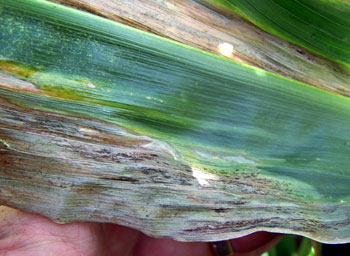Above, Early Goss’s wilt leaf lesion. Note the freckling around the lesion.Below Established Goss’s wilt lesion. Note the shiny exudate on the leaf surface.

Management of Goss’s wilt relies on accurate identification, which can be difficult. If you suspect Goss’s wilt, submit a sample to the Chilvers lab (chilvers@msu.edu; 517-353-9967) or MSU Diagnostic Services for confirmation. For Goss’s wilt management, the field should be rotated away from corn to help reduce the inoculum load, and grass weeds that can harbor the pathogen should also be controlled.
No corn hybrid is completely resistant to Goss’s wilt, but hybrids do differ in their susceptibility, select hybrids with a high level of partial resistance. As the Goss’s wilt pathogen survives on corn residue, cultivation can help by encouraging breakdown of corn debris.
Source : msu.edu